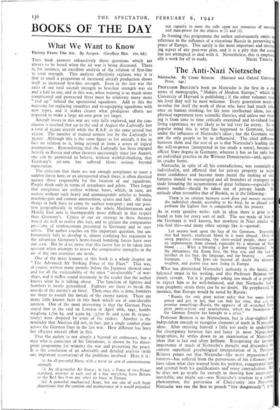BOOKS OF THE DAY
What We Want to Know
Victory From The Air. By Auspex. (Geoffrey Bles. ios. 6d.)
THIS book answers exhaustively those questions which are always to be heard when the air war is being discussed. There is, for instance, an excellent analysis of the relation of first-line to total strength. This analysis effectively explains why it is that so small a proportion of increased aircraft production shows itself as increased first-line strength. Even in the last war the ratio of our total aircraft strength to first-line strength was six and a half to one, and in this war, when training is so much more complicated and protracted there must be relatively many more " tied up " behind the operational squadrons. Add to this the necessity for replacing casualties and re-equipping squadrons with new types, and it makes clearer what prodigious efforts are required to make a large air-arm grow yet larger.
Aircraft losses in this war are very fully explored, and the con- clusion is reached that up to the end of August the Luftwaffe lost a total of 35,000 aircraft while the R A.F. in the same period lost 12,000. The number of trained airmen lost by the Luftwaffe is 35,0oo. Although this is the same figure as for aircraft, it has in fact no relation to it, being arrived at from a series of logical assumptions. Remembering that the Luftwaffe has been engaged heavily in Russia and other theatres unceasingly since last August, one can be permitted to believe, without wishful-thinking, that Germany's air-arm has suffered blows serious beyond expectation.
The criticism that there are not enough aeroplanes to meet a sudden threat here, or an unexpected attack there, is often directed against those responsible for the location of our squadrons. People think only in terms of aeroplanes and pilots. They forget that aeroplanes are useless without bases, which, in turn, are useless without such heavy and unmanageable articles as bombs, machine-gun and cannon ammunition, spares and fuel. All these things in bulk have to come by surface transport ; and our posi- tion geographically in relation to the whole Mediterranean and Middle East area is incomparably more difficult in this respect than Germany's. Critics of our air strategy in these theatres would do well to realise this fact, and to picture the comparative proems of reinforcement presented to Germany and to our- selves. The author touches on this important question, but un- fortunately fails to develop it, almost confining his argument to the advantage Germany's home-based bombing forces have over our own. But he does stress that this factor has to be taken into account when attempts to assess the comparative strengths in the air of the two countries are made.
One of the main features of this book is a whole chapter on " The Advanced Air Striking Force of the Fleet." This was, of course, written many months before the Japanese showed once and for all the vulnerability of the most " invulnerable " of war- ships, and it mates sound testimony to the reader that the author knows what he is talking about. The function of fighters and bombers is neatly generalised. Fighters are there to break the morale of the enemy's air force. Then, once this is done, bombers are there to assault the morale of the enemy nation. There are many little known facts in this book which are of considerable interest. One of the most interesting is that the German Press stated that in the raid on London of April 16th, 1941, bombs weighing 1,700 kg. and 2,500 kg. (3,750 lb. and 5,500 lb. respec- tively) were dropped by some of the raiders. Another is the reminder that America did not, in fact, put a single combat plane across the German lines in the last war. How different has been her effective aircraft effort in this.
That the ambir is not simply a bigoted air enthusiast, but a man who is conscious of his limitations, is shown by his three- point programme for winning the war and preserving the peace. It is the conclusion of an admirable and detailed analysis (with one important reservation) of the problems involved Here it is : (i) An all-powerful Navy, with a naval air arm of commensurate strength.
CO An all-powerful Air Force ; in fact, a Force of two-Power standard, stronger at each end of a line stretching from Britain to the Red Sra than any other air force in Europe.
(iii) A powerful mechanised Army, but not one of such huge dimensions that the creation and maintenance of it would prejudice our capacity to meet the calls upon our resources of mate and man-power for the objects at (t) and (ii).
In framing this pro-gramme the author unfortunately omits reference to the influence of a victorious Russia in preserving peace of Europe. This surely is the most important and interest ing aspect of any post-war plan, and it is a pity that the auth has not attempted to deal with it. Nevertheless, this is emphatic


























 Previous page
Previous page